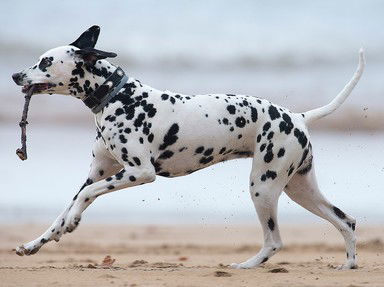Quiz Answer Key and Fun Facts
1. Dalmatians are usually known to be white with black spots, but which of the following colour spots can Dalmatians have?
2. Dalmatians have a uric acid anomaly. What problems does this cause?
3. I hope you've seen the move "101 Dalmatians" that was released by Disney. If you did, ignore this one scene, but, even if not, can you tell me what colour are Dalmatian puppies when they are born?
4. What were Dalmatians originally bred for?
5. Approximately 30% of Dalmatians are affected by a congenital problem. What is their impediment?
6. Dalmatians are widely believed to have originated in the region of Dalmatia. Where in the world is this located?
7. Which of these adjectives best describes a Dalmatian's personality?
8. Which class of dog do Dalmatians compete in, according to the American Kennel Club?
9. Dalmatians have had many names over the years, though none of them seemed to stick except for "Dalmatian". Which of these names was *not* one of the names associated with our four-legged friends?
10. The Disney movie "101 Dalmatians" did harm to the breed of Dalmatians, and created a phenomenon called "101 Dalmatians Syndrome".
Source: Author
LeoDaVinci
This quiz was reviewed by FunTrivia editor
rossian before going online.
Any errors found in FunTrivia content are routinely corrected through our feedback system.
